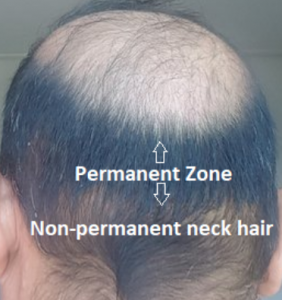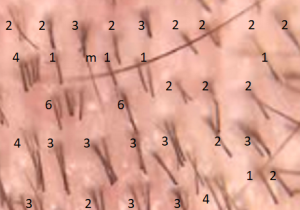How to determine donor supply
Here is a picture of the donor area of a man who asked me: How much donor hair do I have? He asks: You have talked about the Donor Bank in your writings, so I would like to know how many grafts are in my Donor Bank and what will be my lifetime supply of grafts for hair transplants in case I should become very bald?
First let’s see where the permanent zone of hair can be found. It is called the permanent zone because even the baldest of men, never lose hair in this zone (see photo below). The zone measured from 2.5-3 inches in height and extends around the entire head from temple prominence on the right side to temple prominence on the left side. We generally assume (safely so) that this hair will always remain (regardless of the balding pattern a man develops). Back in the late 1950, a doctor ‘Orentriech’ discovered that if this hair is moved anywhere on the body, even into a bald area of the scalp, it would grow as it would have grown in its home location in this permanent zone. That is why it is called the permanent zone of hair.
There are two important numbers to determine from the hair in this zone (1) the hair count per follicular unit (these are the groups of hairs that contain one or more hairs each in them) and the thickness of the hair shafts of this permanent hair (never look at the hair you are losing as normal hair as it often gets thinner and thinner). I quantify the thickness of each hair shaft in the permanent zone by feel (experience helps here) or with a micrometer as Fine (~40 microns or less in thickness), Average (~60 microns in thickness) or Coarse (70+ microns in thickness).
I generally take a picture of the donor area with the hairs cut short enough that I can count the number of follicular groups in the field of view and how many hairs are in each group (see below). This field of view of the donor area of one of my patients was taken with a purchased lens as an attachment for my cell phone (https://www.amazon.com/gp/product/B07S5YPPQX?pf_rd_p=ab873d20-a0ca-439b-ac45-cd78f07a84d8&pf_rd_r=CCSSMZGDS79G6AG31TT9) at a cost of $16, something you should consider purchasing.
First let’s do some simple math: There are 34 individual hair groups (shown in the area shown in the photo) which contain from one to 6 hairs each (each are counted and labeled for you). The total hair count in this field is 85 hairs. If we divide the number of hairs by the number of groups 85/34= 2.5 hairs per Follicular unit (a Follicular Unit is essentially what we call a Graft in a hair transplant surgery). The average Caucasian has 2.2 hairs per Follicular Group so the man shown here has a hair count that is 13% higher than average. I can tell from this number that this man has 125,000 birth hairs on his head regardless of how much hair he has already lost. I felt his hair for thickness and measured it. It measured 60 microns which is essentially an average weight hair.
Now let’s look at more detail at this picture. There is a single hair shown that I labeled ‘m’ for a miniaturized hair. So this man had approximately 1% miniaturized hairs. The number of miniaturized hairs can be as high as 20% and the donor area is still considered healthy. As we get older (into your 50-90s) these hair groups may drop hairs so that the count could be slightly lower and the hairs that we often drop will often be miniaturized before they fall out. Everyone experiences hair changes with age, as donor area hairs may get ‘finer’ so that they contain less hair bulk per hair shaft. If these hairs are used for a hair transplant, whatever happens in this permanent zone, will happen in the hair transplanted hairs as well.
The calculations of his total donor bank supply is a bit more complicated. Each person has a fixed number of Follicular units (about 50,000 for an average sized head) and the hairs in these follicular units can be counted. Generously assuming that the size of the donor area is between 20-25% of the total hair baring scalp (let’s use 25% as a number for calculations here), this patient has 31,250 hair in his permanent zone or 12,500 follicular units (grafts) of which he can transplant theoretically no more than 60% of these hairs (follicular units or grafts). The 60% number is based upon an average hair count, but because this man has 13% more hair, he can actually move 13% more grafts bringing his total available lifetime hair to 7,500 * 1.13 = 8,475 grafts available during his lifetime.
Experienced surgeons like me who have been measuring hair densities since I first entered the practice and defined it in the literature, have learned when they can increase even this number safely. This is where surgical judgment comes in. I would like you to try to make this important assessment of your Donor Bank so that you will be able to (1) test the doctor’s knowledge of what he says about your donor supply, (2) be confident that your donor quality and quantity is adequate to meet your short and long term hair transplant needs.



Reader Comments0
Share this entry
Leave a Comment
Want to join the discussion? Feel free to contribute! Note: We do not tolerate offensive language or personal attacks to other readers. Marketing links or commercial advertisements will be deleted.